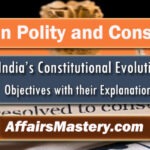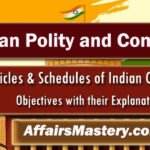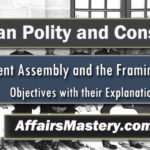Set 7 | Important Indian Constitution Evolution MCQs
Important Indian Constitution Evolution MCQs. The way the Indian Constitution has evolved over time plays a huge role in shaping Indian Polity and Governance, and it’s one of those things that really lays the groundwork for doing well in competitive exams—whether it’s Civil Services, State exams, SSC, Railways, Banking, or any of the others out there. Diving deep into Indian Polity, Constitution, and governance isn’t just about memorizing facts or ticking boxes for exams, but more about developing the kind of awareness that can make navigating these challenging exams a little less overwhelming and a lot more manageable.
| MCQs on Indian Constitution Evolution – Objective Questions and Answers |

Q61. Constitution Day of India is celebrated on (60th to 62nd B.P.S.C. (Pre) 2016)
[A] 26th October
[B] 26th November
[C] 26th January
[D] 15th August
[E] None of the above/More than one of the above
View Explanation
Correct Answer is B.
- 26th November is when Constitution Day, also called Samvidhan Divas, is observed in India. This is the date back in 1949 when the Indian Constitution was officially adopted. It didn’t come into full effect right away, though.
- That happened later, on 26th January 1950, which is why that day is celebrated as Republic Day. But 26th November is significant ‘cause that’s when the foundation was laid for how the country would be governed.
- It’s a day to recognize the vision of Dr. B.R. Ambedkar and all those who played a part in shaping the laws and rights that run the nation today.
Q62. B.R. Ambedkar was elected to the Constituent Assembly from– (I.A.S. (Pre) 1996)
[A] West Bengal
[B] Bombay Presidency
[C] Middle India
[D] Punjab
View Explanation
Correct Answer is B.
- Back in 1946, when the preliminary elections were held, Dr. B.R. Ambedkar got elected from the eastern side of undivided Bengal. But then, after things changed and that region ended up becoming a part of Pakistan, he had to be elected again.
- This time, he got a seat from Pune, which was under the Bombay Presidency back then. That particular seat had opened up because M.R. Jaikar stepped down.
- Now, since Ambedkar originally got elected from East Bengal—not West Bengal—option (b) stands as the right choice.
Q63. Year of birth and death of Dr. B.R. Ambedkar – (M.P. P.C.S. (Pre) 1992)
[A] 1886, 1951
[B] 1891, 1956
[C] 1877, 1961
[D] 1889, 1961
View Explanation
Correct Answer is B.
- Dr. B.R. Ambedkar was born on April 14, 1891, and he passed away on December 6, 1956. He was the chief architect of the Indian Constitution and a prominent social reformer who fought against caste discrimination.
Q64. In which year was ‘Jana Gana Mana’ adopted as the National Anthem of India? (R.A.S./R.T.S. (Pre) 1996)
[A] 1948
[B] 1949
[C] 1950
[D] 1951
View Explanation
Correct Answer is C.
- ‘Jana Gana Mana‘ was officially adopted as the National Anthem of India on January 24, 1950, by the Constituent Assembly.
- Originally composed in Bengali by Rabindranath Tagore in 1911, it was later adopted in its Hindi version as the national anthem when India became a republic.
Q65. The state emblem was adopted by Govt. of India on – (M.P.P.C.S. (Pre) 1999)
[A] 15th August, 1948
[B] 2nd October, 1947
[C] 26th January, 1948
[D] 26th January, 1950
View Explanation
Correct Answer is D.
- The State Emblem of India, which is an adaptation of the Lion Capital of Ashoka at Sarnath, was officially adopted by the Government of India on 26th January 1950—the same day India became a Republic.
- The emblem symbolizes power, courage, and confidence, and it features the inscription “Satyameva Jayate” (Truth Alone Triumphs) from the Mundaka Upanishad.
Q66. Consider the following statements: (I.A.S. (Pre) 2009)
1. The discussions in the Third Round Table Conference eventually led to the passing of the Government of India Act, 1935.
2. The Government of India Act, 1935 provided for the establishment of an All India Federation to be based on a Union of the Provinces of British India and the Princely States.
Which of the statement(s) given above is/are correct?
[A] 1 only
[B] 2 only
[C] Both 1 and 2
[D] Neither 1 nor 2
View Explanation
Correct Answer is C.
- During the Third Round Table Conference, a plan was brought forward with the intention of shaping what later became the Government of India Act, 1935.
- This Act had an important provision, which was about forming an All India Federation that would include both British India and all those Princely States. Now, if we look at this, it’s pretty obvious that both of these statements are correct.
- The Third Round Table Conference actually took place in 1932 in London, but one big thing about it was that Congress didn’t take part in it.
- Their absence made a huge difference because, without their participation, the conference didn’t really have the same weight as it could have had.
Q67. Here are two statements: (U.P. P.C.S. (Spl) (Mains) 2008)
Statement(A) : The Constitution of India provides for all necessities of the country.
Reason (R) : It is known or called as ‘Adopted’ Constitution.
In relation to aforesaid which one is true ?
[A] (A) and (R) both are true and (R )is correct explanation of (A).
[B] (A) and (R) both are true but (R) is not the correct explanation of (A).
[C] (A) is true but (R) is wrong
[D] (A) is wrong but (R) is true.
View Explanation
Correct Answer is B.
- The Indian Constitution is designed in a way that it covers all the essential needs of the country. Not just that, it also has the flexibility to adapt to future changes since it includes a provision for amendments.
- At the same time, it has drawn inspiration from the constitutions of different countries, taking in various principles and ideas. Because of this, many refer to it as an ‘Adopted Constitution’ since it incorporates elements from multiple sources.
- Now, looking at both statements (A) and (R), they are indeed true. However, (R) doesn’t exactly explain (A) in a direct way, which means while both stand correct, (R) isn’t the proper reason behind (A).
Q68. Deferment of Adult Franchise for fifteen years was advocated in Constituent Assembly by – (M.P.P.C.S. (Pre) 2010)
[A] Dr. Rajendra Prasad
[B] Jawaharlal Nehru
[C] Maulana Azad
[D] Dr. Bhim Rao Ambedka
View Explanation
Correct Answer is C.
- Maulana Abul Kalam Azad, a prominent leader in the Constituent Assembly, had advocated for the deferment of adult franchise for fifteen years.
- He believed that India needed time to prepare its citizens, especially given the widespread illiteracy and lack of political awareness at the time.
Q69. Consider the following statements and choose the correct answer by using the codes given below: (U.P.P.C.S. (Pre) 2017)
Assertion (A) : India is a democratic country.
Reason (R) : India has a constitution of its own. Code :
[A] Both (A) and (R) are true and (R) is the correct explanation of (A).
[B] Both (A) and (R) are true but (R) is not the correct explanation of (A).
[C] (A) is true but (R) is false.
[D] Both (A) and (R) are false.
View Explanation
Correct Answer is B.
- India is a democratic country because it follows the principles of universal adult franchise, free and fair elections, fundamental rights, and representative government. This makes Assertion (A) true.
- India also has its own Constitution, which provides the framework for governance, law, and institutions. Reason (R) is also true.
- However, just having a constitution does not automatically make a country democratic. A constitution can exist in both democratic and non-democratic states.
- Democracy is defined by the principles and functioning of governance, not merely by the presence of a constitution. That’s why (R) is not the correct explanation of (A), making option [B] the right choice.
Q70. Who amongst the following advised that the Indian National Congress should be disbanded as a political party after the independence of India? (U.P.P.C.S. (Mains) 2011)
[A] C. Rajagopalachari
[B] Jai Prakash Narayan
[C] Acharya Kripalani
[D] Mahatma Gandhi
View Explanation
Correct Answer is D.
- After India gained independence in 1947, Mahatma Gandhi believed that the Indian National Congress (INC) had fulfilled its primary purpose of achieving freedom from British rule.
- He felt that the party should now be disbanded and transformed into a social service organization rather than continue as a political party.
- Gandhi suggested that the Congress should focus on nation-building, rural development, and social upliftment instead of engaging in power politics.
- However, his advice was not followed, and the Congress continued as a political party, eventually becoming the dominant force in Indian politics for several decades.
Related articles:
- Set 1 | Important Indian Constitution Evolution
- Set 2 | Important Indian Constitution Evolution
- Set 3 | Important Indian Constitution Evolution
- Set 4 | Important Indian Constitution Evolution
- Set 5 | Important Indian Constitution Evolution
- Set 6 | Important Indian Constitution Evolution
- Set 8 | Important Indian Constitution Evolution



